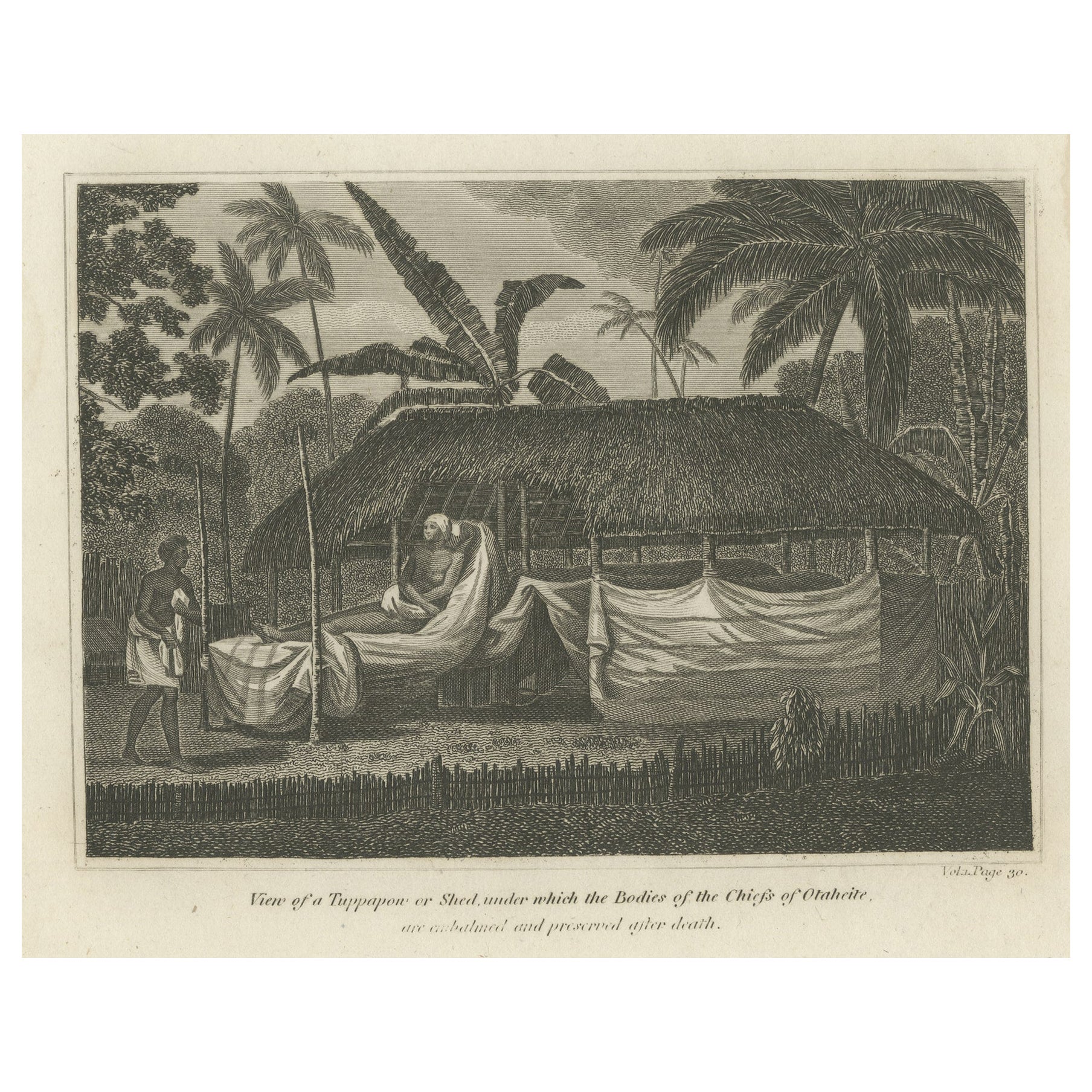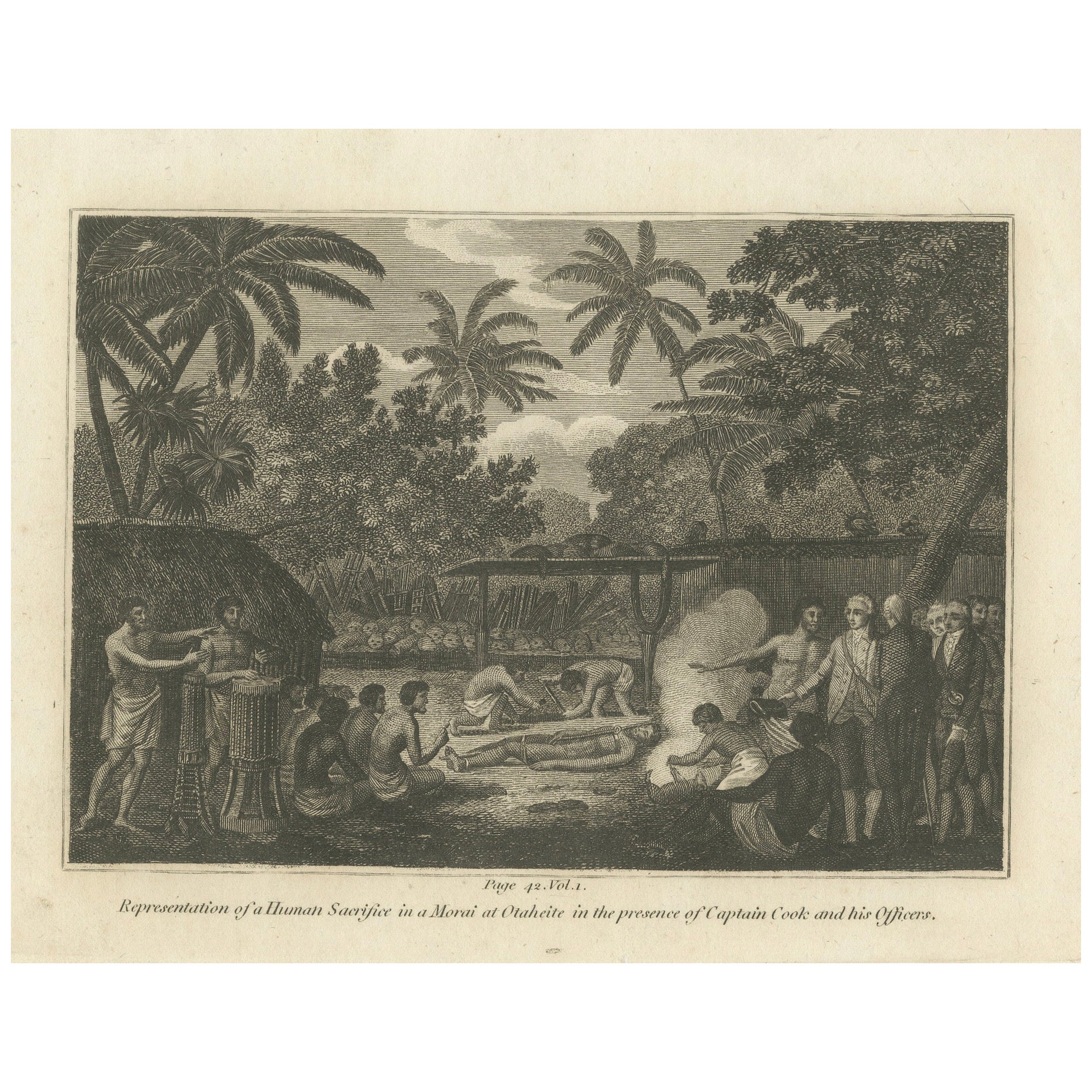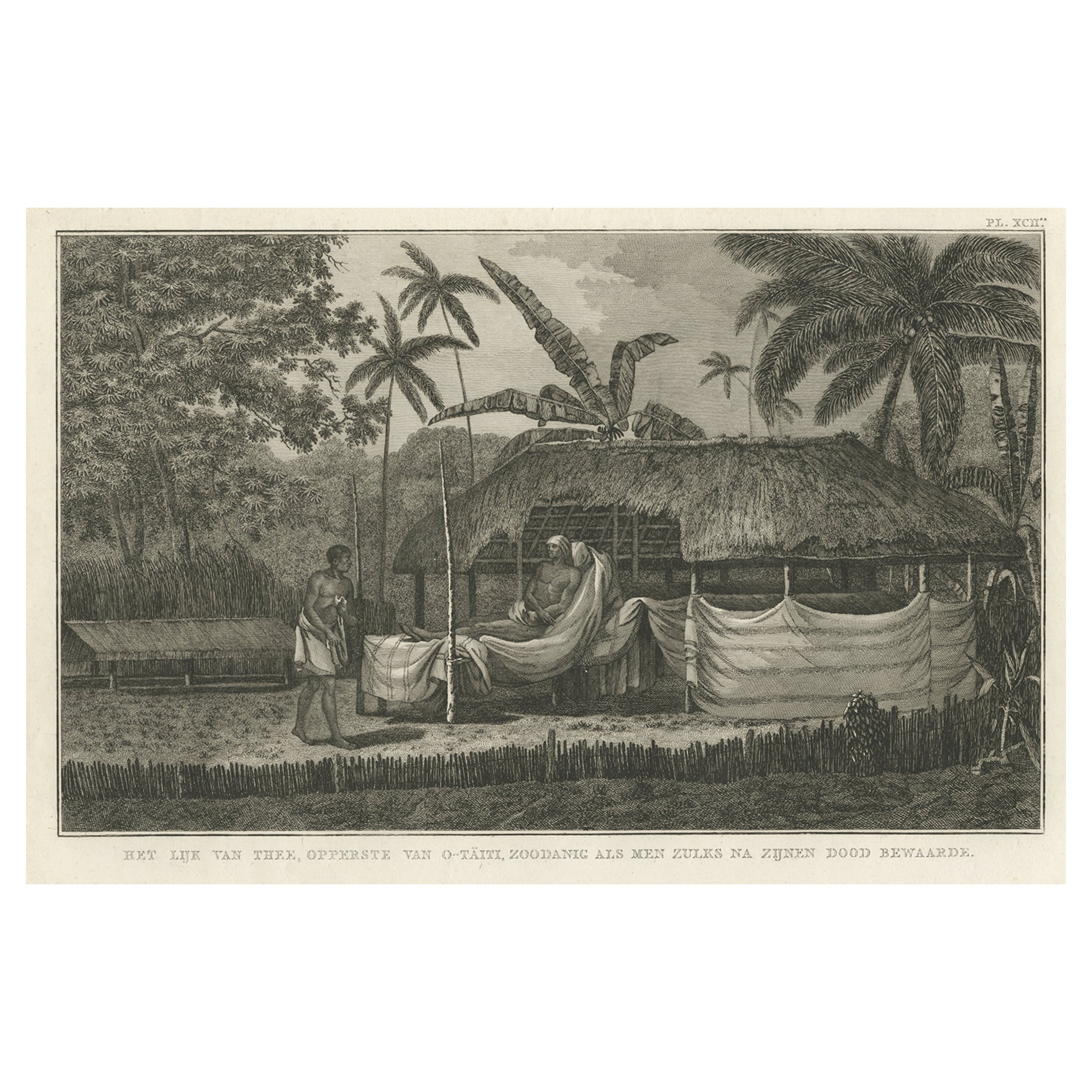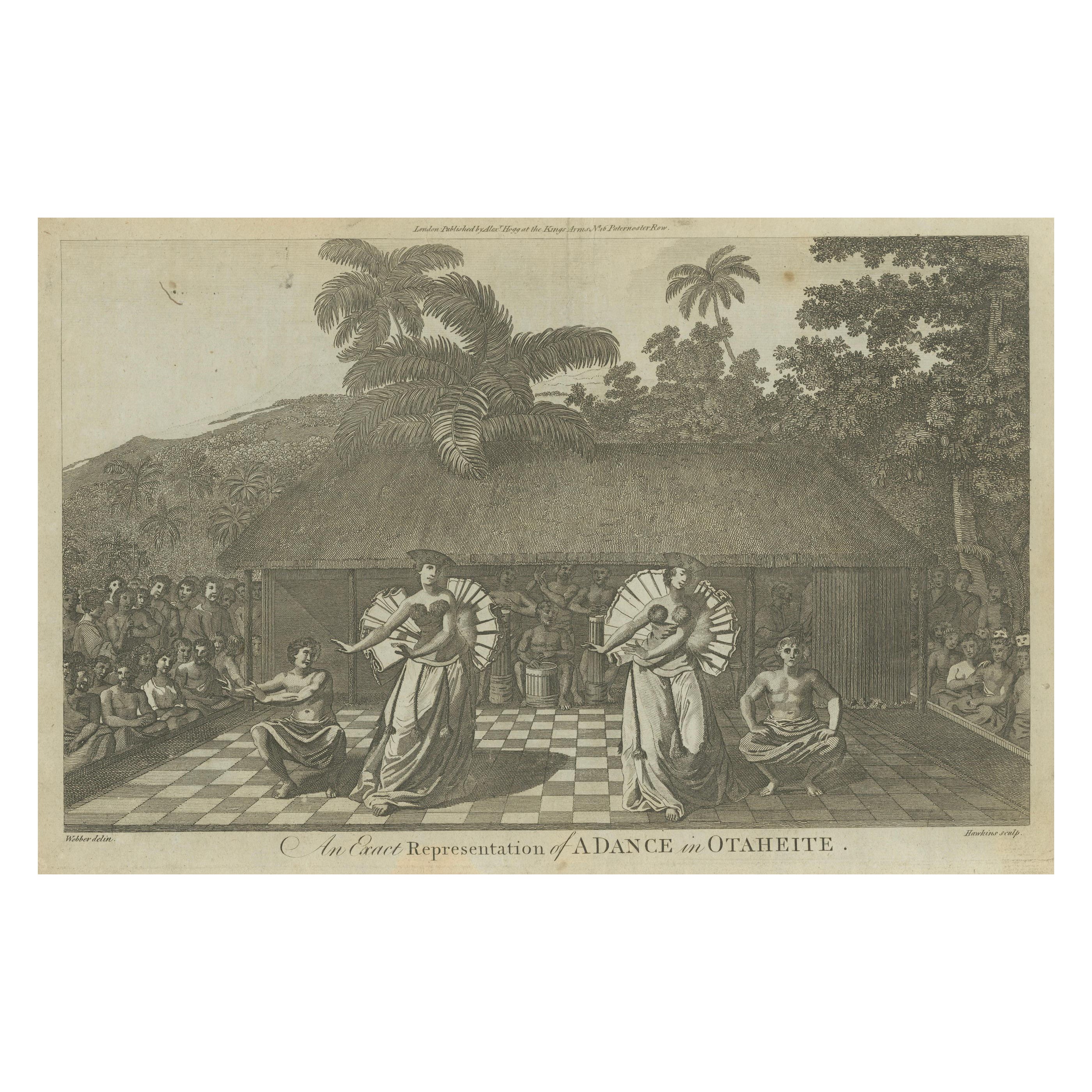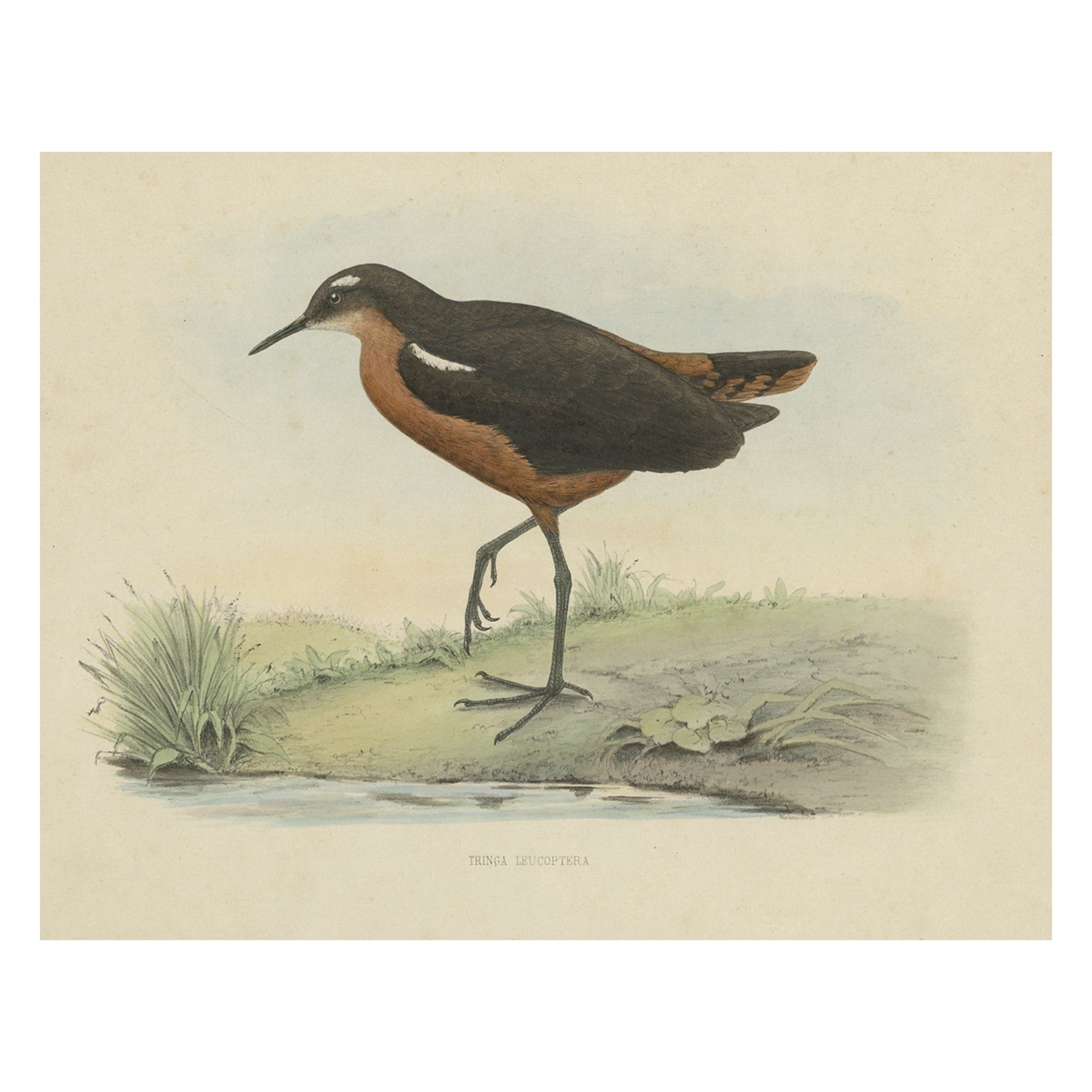Items Similar to Tee's Eternal Rest: The Embalmed Chief of Otaheite or Tahiti, circa 1800
Want more images or videos?
Request additional images or videos from the seller
1 of 6
Tee's Eternal Rest: The Embalmed Chief of Otaheite or Tahiti, circa 1800
About the Item
Title: "Tee's Eternal Rest: The Embalmed Chief of Otaheite"
Description: This engraving, after a drawing by John Webber, depicts the preserved body of Tee, a chief from Otaheite (Tahiti), following his death. The artwork originates from an account of Captain James Cook's third voyage and showcases the practice of preserving the dead in Tahitian culture. The scene takes place in Matavai Bay, a significant location during the era of exploration, already famed through earlier visits and the engravings of Sydney Parkinson and William Hodges.
In the foreground, we see the tupapau, an elevated platform, which holds the body of Chief Tee. His body has been embalmed, a process that has successfully maintained its condition for over four months despite the humid climate of Tahiti. The engraving reflects the respect and honor accorded to the deceased chief, with his body carefully shrouded, echoing the practices of European art and recalling classical themes such as depicted in Nicolas Poussin's "The Death of Germanicus."
The image captures a tranquil and solemn moment within a lush tropical landscape, characterized by the thatched structures of the Tahitian people and the rich vegetation of palm trees. An attendant figure is seen by the side of the platform, reinforcing the sense of ongoing care and respect for the departed. John Webber's work, while documenting the cultural practices of the Pacific peoples encountered by Cook, is also steeped in the artistic conventions of his European heritage.
- Dimensions:Height: 8.27 in (21 cm)Width: 10.63 in (27 cm)Depth: 0 in (0.02 mm)
- Materials and Techniques:Paper,Engraved
- Period:
- Date of Manufacture:circa 1817
- Condition:Good. Overal light foxing and some soiling and offset. Image itself undisturbed and sharply detailed. Aged paper with typically warm, yellowish-brown hue, mostly around the edges. Please study the images carefully.
- Seller Location:Langweer, NL
- Reference Number:
About the Seller
5.0
Platinum Seller
These expertly vetted sellers are 1stDibs' most experienced sellers and are rated highest by our customers.
Established in 2009
1stDibs seller since 2017
1,922 sales on 1stDibs
Typical response time: <1 hour
- ShippingRetrieving quote...Ships From: Langweer, Netherlands
- Return PolicyA return for this item may be initiated within 14 days of delivery.
More From This SellerView All
- Mourning the Chief: Engraving of The Morai at Otaheite, now called Tahiti, 1817Located in Langweer, NLAn original historical engraving from G. Alexander Cooke's "Geography," published in 1817. The engraving is titled "View of a Tuppapon or Shed under which the Bodies of the Chiefs of...Category
Antique 1810s Prints
MaterialsPaper
- Ceremonial Rites: A Human Sacrifice in Otaheite (Tahiti), 1801Located in Langweer, NLThe title for the provided engraving could be "Ceremonial Rites: A Human Sacrifice in Otaheite," capturing the gravity of the depicted event. This print likely illustrates a solemn a...Category
Antique Early 1800s Prints
MaterialsPaper
- Antique Engraving of the Dead Chief of Tahiti Island in the Pacific, 1803By James CookLocated in Langweer, NLAntique print titled 'Het Lijk van Thee, Opperste van O-Tahiti, zoodanig als men zulks na zijnen dood bewaarde'. Antique print depicting the remnents of Thee, Chief of Tahiti. Origin...Category
Antique 19th Century Prints
MaterialsPaper
- Celebration of Tahitian Culture: Traditional Dance at Otaheite, circa 1785Located in Langweer, NLAn antique engraving depicting a dance scene titled "An Exact Representation of a Dance in Otaheite," Otaheite being an archaic name for Tahiti in French Polynesia. This engraving would have been created as a part of a series to document the culture and life of the Tahitian people, likely observed by European explorers during one of the many voyages to the South Pacific in the 18th century. In the foreground, there are central figures engaged in a dance, wearing traditional Polynesian attire, which includes wraps around their waists and adornments that seem to represent status or a part of the dance costume. They are holding what appear to be fans, which may be part of the traditional dance. The dancers' poses suggest movement and a performance aspect to the scene. Behind the dancers, we can see a group of musicians providing the accompaniment, playing drums, which indicates the importance of music and rhythm in the dance. To the right, there is an audience of seated individuals, likely members of the community, watching the performance. The background of the scene includes thatched huts and a lush landscape with palm trees, depicting a typical village setting in Tahiti. The checkerboard pattern on the ground where the dance takes place is notable, as it adds a sense of structure to the scene. This image would have been intended for a European audience unfamiliar with Tahitian culture and would have served as a visual record of the encounters between European explorers and the peoples of the Pacific Islands. The engraving you've uploaded, titled "An Exact Representation of a Dance in Otaheite," is likely from a work documenting the voyages of Captain James Cook, given the style and subject matter. Captain Cook made three voyages to the Pacific Ocean during the 18th century, and his encounters with the peoples of the Pacific, including those of Tahiti (Otaheite), were extensively recorded and published. The engravings from Cook's voyages were made by artists who accompanied him, such as John Webber on his third voyage, or were based on sketches made by other crew members. These images were then published in the official accounts of the voyages. The most notable of these accounts is "A Voyage to the Pacific Ocean" undertaken during Cook's third voyage from 1776 to 1780, which was published in the years following his death in 1779. Another possible source for this engraving could be from the accounts of Joseph Banks. Banks was a naturalist who joined Cook on his first voyage (1768-1771) aboard the HMS Endeavour and was responsible for extensive collections and descriptions of Pacific cultures. His collections and later works also included illustrations and engravings of the scenes and peoples encountered. Given that the engraving is labeled as "London Published as the Act directs by Alexr. Hogg at the Kings Arms...Category
Antique 1780s Prints
MaterialsPaper
- Old Bird Print of the Tahiti Sandpiper or Tahitian Sandpiper, 1854Located in Langweer, NLAntique print titled 'Tringa Leucoptera'. Old bird print of the Tahiti sandpiper or Tahitian sandpiper (Prosobonia leucoptera). This print originates from 'Bijdragen tot de Dierk...Category
Antique 1850s Prints
MaterialsPaper
- Portraits of Encounter: Chief Potatow and Omai of Tahiti, Engraved in ca.1777Located in Langweer, NLThe original antique engraving for sale presents side-by-side portraits of two individuals from Tahiti, labeled as "Portrait of POTATOW" and "Portrait of OMAI." The style of the engr...Category
Antique 1770s Prints
MaterialsPaper
You May Also Like
- Set of 3 Original Antique Prints of Ancient Egypt, Circa 1800Located in St Annes, LancashireGreat images of ancient Egypt Copper-plate engravings. Published C.1800 Unframed.Category
Antique Early 1800s English Egyptian Prints
MaterialsPaper
- Original Antique Print of The Royal Golden Barge, Myanmar. C.1800Located in St Annes, LancashireWonderful print of the Royal Golden Barge Copper-plate engraving Published C.1800 Unframed.Category
Antique Early 1800s English Chinoiserie Prints
MaterialsPaper
- 1800 Russian Imperial-era Paul I View of the Town of Gatchina EngravingLocated in St. Catharines, ONVue du Connétable de la ville de Gatchine (View of the Obelisk of Town of Gatchina) circa 1800. After an original by Semion Fedorovich Shchedrin, 1798. Engraving, 13 x 18 in. (33 ...Category
Antique Early 1800s Russian Romantic Prints
MaterialsPaper
- Original Antique Equestrian Portrait Print, circa 1800Located in St Annes, LancashireWonderful print of a Yeoman of The Guard Copper-plate engraving after N.C Goodnight Published circa 1800 Unframed.Category
Antique Early 1800s English Elizabethan Prints
MaterialsPaper
- The Eruption of Vesuvius 14 May 1771 by Heinrich Guttenberg, c. 1800Located in Kenilworth, ILEruption du Mont Vésuve, du 14 Mai, 1771 (Eruption of Mt. Vesuvius, May 14, 1771) is an engraving by Heinrich Guttenberg after a painting by Pierre-Jacques Volaire. In this imposing...Category
Antique 19th Century Prints
MaterialsPaper
- Set of FOUR Parrot Prints originally Circa 1800s in Rectangular Frames, NewBy John James AudubonLocated in Lincoln, LincolnshireThese are a set of FOUR digitally remastered prints of Parrots, hand coloured framed prints, originally from Circa 1800s. Prints of this style we...Category
2010s British Victorian Prints
MaterialsGlass, Wood, Paper
